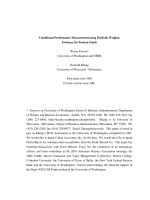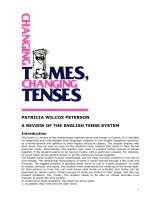Conditional tense (El tiempo condicional)
Bạn đang xem bản rút gọn của tài liệu. Xem và tải ngay bản đầy đủ của tài liệu tại đây (116.62 KB, 10 trang )
Unit 9 (Unidad 9)
Conditional tense (El tiempo
condicional)
Level 1
1.1 The conditional (El condicional)
1.1 The conditional
i This tense corresponds to the English would,soithas a future idea, both in form and
usage. Its endings are added to the full infinitive, just as with the future tense. You
should not find the formation of the conditional difficult if you have no trouble with
the future. Here are the forms of the conditional:
-
´
ıa comprar
´
ıa vender
´
ıa vivir
´
ıa
Sing. -
´
ıas comprar
´
ıas vender
´
ıas vivir
´
ıas
-
´
ıa comprar
´
ıa vender
´
ıa vivir
´
ıa
-
´
ıamos comprar
´
ıamos vender
´
ıamos vivir
´
ıamos
Plur. -
´
ıais comprar
´
ıais vender
´
ıais vivir
´
ıais
-
´
ıan comprar
´
ıan vender
´
ıan vivir
´
ıan
ii Here are the conditionals of twelve irregular verbs. These follow the pattern of the
future of these irregular verbs:
Future Conditional
caber: cabr´e cabr´ıa> cabr´ıas, etc.
decir: dir´e dir´ıa> dir´ıas, etc.
haber: habr´e habr´ıa> habr´ıas, etc.
hacer: har´e har´ıa> har´ıas, etc.
poder: podr´e podr´ıa> podr´ıas, etc.
poner: pondr´e pondr´ıa> pondr´ıas, etc.
querer: querr´e querr´ıa> querr´ıas, etc.
saber: sabr´e sabr´ıa> sabr´ıas, etc.
salir: saldr´e saldr´ıa> saldr´ıas, etc.
tener: tendr´e tendr´ıa> tendr´ıas, etc.
valer: valdr´e valdr´ıa> valdr´ıas, etc.
venir: vendr´evendr´ıa> vendr´ıas, etc.
The conditional always depends upon a past tense, expressed or understood. Its primary
value is to convey a future idea or event from a past time. It bears the same relationship to
a past tense as the future does to the present tense. It is helpful to see the future alongside
the conditional. Compare the sentences in the sets below:
71
ASTUDENT GRAMMAR OF SPANISH
Te aseguro que lo har´e I assure you that I’ll do it
Te aseguraba que lo har´ıa I assured you that I would do it
Voyapreguntarle si llegar´apronto I’ll ask her if she’ll arrive soon
Iba a preguntarle si llegar´ıa pronto I was going to ask her if she would arrive
soon
Te digo que regresar´ema˜nana I tell you I’ll return tomorrow
Te dije que regresar´ıa ma˜nana I told you I would return tomorrow
iii In this manner the conditional is extended to apply as a future after any past
tense, whether indicative or subjunctive (see unit 16, level 2 on the subjunctive, for
examples).
Era seguro que tendr´ıa raz´on It was certain that he would be right
Pens´e que tal vez la encontrar´ıa por aqu´ı I thought that perhaps I’d find her here
Exercises
Level 1
i Change the infinitive to the conditional in the following sentences:
Example
Le dije que (venir) ma˜nana > Le dije que vendr´ıa ma ˜nana
a Te expliqu´e que (llegar) mis parientes antes
b Nos avisaron que la boda (ser) a las doce
c Luisa dijo que (ir) a la modista
d Me coment´o que (aprender) a conducir
e Pensamos que era tarde y que no (servir) comidas
f Le platiqu´e que no (poder) regresar mis hermanos
g Contestamos que el precio de la casa (ser) demasiado alto
h Le promet´ı que mis abuelos (cuidar) a los ni˜nos
i Les dije que nosotros (coincidir) en Barcelona
j Supuse que t´u (comprar) las flores
ii Change as in the example, i.e. present + future > preterit/imperfect + conditional
Example
Creo que (´el) tendr´a bastante dinero > Cre´ıa que tendr´ıa bastante dinero
a Dice que saldr´aalas nueve
b Opinamos que no vendr´an sus pap´as
c Dicen que no habr´a luz ma˜nana
d Luis cree que Ana no har´a nada
e Pedro me avisa que el cartero no vendr´am´as tarde
f ¿Por qu´emecomentas que rentar´as un carro (M)?
g Supongo que har´afr´ıo ma˜nana
h Creo que aprobar´aelexamen
i Piensa que pondr´an la pel´ıcula Casablanca esta noche
j Estoy seguro de que nevar´a esta tarde
iii Paired activity
Objective –Topractice the conditional used after the imperfect or preterit
Method –The first person (A) starts a sentence with either the imperfect tense (see
unit 7 forareminder) or the preterit (see unit 8 forareminder). The second person (B)
completes the sentence with a conditional. Try to complete six sentences
72
9 Conditional tense
Examples
A: Le dije que (
)
B: (yo) ir´ıa esta tarde
A: Les promet´ıa cada d´ıa que (
)
B: regresar´ıamos el a ˜no que viene
See further examples in 9.1.1. ii and iii
iv Activity for one brave person to face the whole class and explain how the Spanish
conditional is formed and how it is used in Spanish. Is the formation of the Spanish
conditional easier than in English? Is it useful to know the formation of the future
in Spanish in this context? The adventurous person could obtain cooperation and
her/his answers from the class. This could be an activity to be prepared for next
week.
Level 2
2.1 Conditional perfect (Pret
´
erito condicional)
2.1 Conditional perfect
This tense conveys an idea or an event related to the future in the past. It corresponds
to the English would have done/spoken/walked, etc. = habr´ıa hecho / hablado / caminado (M)/
andado.Ithas a complication in that it often involves the use of the subjunctive, and you
are referred to the subjunctive (see unit 16, especially level 2). As in the example above,
the conditional perfect is formed by the conditional of the verb haber followedbythe
past participle of the main verb. In other words, its formation is the auxiliary or helping
verb haber + past participle.
Ejemplos
habr´ıa/habr´ıas/habr´ıa/habr´ıamos/habr´ıais/habr´ıan comprado = Iwould have bought, etc.
habr´ıa..............vendido = Iwould have sold, etc.
habr´ıa..............vivido = Iwould have lived, etc.
Besides this temporal function, the conditional perfect is also used to suggest supposition
and hypothesis, with the idea of must have or probably*
Examples
Ya habr´ıa llegado cuando salimos She must have arrived when we left
Habr´ıa escrito la carta antes He must have written the letter before
Seg´un la polic´ıa cuatro pandilleros (M) habr´ıan
cometido el delito
According to the police, four delinquents
must have committed the offense
*The conditional perfect corresponds to the preterite use of deber de as in:
Debi´odeacabar el trabajo ayer She must have finished the work yesterday
Deb´ıdeperder el conocimiento Imust have lost consciousness
Debi´odehacer fr´ıo It must have been cold
There is some uncertainty among many Spanish speakers whether deber should be
followed by de in this construction. However, the consensus among grammarians is that
the construction should be deber de.
73
ASTUDENT GRAMMAR OF SPANISH
Exercises
Level 2
i Cambia como en el ejemplo – presente + futuro > pret´erito/imperfecto +
condicional:
Creo que los plomeros (M)/fontaneros habr´an terminado el trabajo para las seis >
Cre´ı/Cre´ıa que los plomeros/fontaneros habr´ıan terminado...
a Su padre dice que habr´a acabado el examen
b Estamos seguras de que habr´an arreglado el carro (M)
c Es casi cierto que se habr´a descompuesto (M)/averiado la lavadora
d Nos advierte que habr´a llovido antes de la noche
e Nos promete que habr´an cargado los camiones a las seis
f Sugiere que el conflicto se habr´aresuelto a finales de mes
g Contesta que habr´an construido el edificio dentro de un a˜no
h Me informa que habr´an corregido en breve los errores del horario
i Te garantizo que el abogado nos habr´a entregado el documento a las dos
j El comandante insiste en que la guerra habr´a terminado en enero
k Estoy convencida de que los polic´ıas habr´an hallado (M)/encontrado al chico
perdido
ii Actividad en parejas
Objetivo – estudiar la concordancia entre el pret´erito y el condicional
M
´
etodo –lapareja colabora para crear seis frases que incluyan un verbo en pret´erito y
un verbo en condicional. Despu´es, varias parejas le presentan sus frases a la clase entera.
Abajo, encuentran una serie de verbos en pret´erito que pueden ayudarlos a empezar la
frase:
Estuve, fue, sugerimos, advert´ı, contestaron, dijimos, avisamos, coment´o, aseguraron,
pregunt´o
Ejemplos
La polic´ıa nos advirti´o que los ladrones regresar´ıan
Supuse que nos dar´ıan el dinero
74
Unit 10 (Unidad 10)
Progressive tense or gerund
(El tiempo progresivo o el gerundio)
Level 1
1.1 The present participle of the verb (El participio activo del verbo)
1.1 The present participle of the verb
i The place of the present participle, as part of the verb, has been taken by a form
adopted almost unchanged from the Latin and called the gerund.Inregular -ar verbs
this is formed by adding -ando to the stem; in regular -er and -ir verbs by the addition
of -iendo:
comprar > comprando to buy > buying
vender > vendiendo to sell > selling
vivir > viviendo to live > living
This is also the case in most of the irregular verbs:
dar > dando hacer > haciendo ser > siendo
estar > estando querer > queriendo tener > teniendo
haber > habiendo salir > saliendo ver > viendo
Some irregular verbs are slightly different:
caer > cayendo construir > construyendo dormir > durmiendo
ir > yendo o´ır > oyendo traer > trayendo
ii The distinctive feature of the gerund is that it can be combined with different tenses,
as in the examples below:
¿Qu´e est´a haciendo Pap´a? Est´aleyendo el peri´odico What’s Pa/dad doing? He’s reading the
newspaper
Est´a tocando el viol´ın She’s playing the violin
¿De qu´e est´an/est´ais hablando? What are you talking about?
¿Qu´e has estado haciendo hoy? What have you been doing today?
Estaba yo escribiendo cuando entr´o I was writing when she came in
Ma˜nana a estas horas estaremos viajando At this time tomorrow we’ll be traveling
Thepreterit of estar (estuve, etc.) is also used in the same way but this will be treated
in level 2.
75









